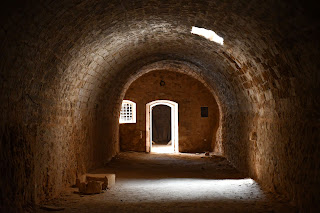Crete: A walk around Rethymno
I made my latest journey in the company of my mum and one of my sisters. For this reason – and because the daily temperatures have consistently risen into the high thirties – my trips have been much more leisurely than usual. We arrived in Crete on the evening of the 22nd after an eventful journey. Our flight was delayed by almost two hours: first because a problem had to be fixed on our aircraft, and then because our plane missed our departure window and had to wait for another hour. In the meantime, a storm brewed up somewhere above southeastern Europe, and we flew straight into it for a bumpy flight.
We arrived in
Heraklion but rented a car, as the apartment we were renting lay about an
hour’s drive east in Rethymno. I visited Rethymno on our first full day on the
island: I started at the Church of Four Martyrs, walking north through the
Venetian Porta Guora. The town has passed through a number of hands, which
remain imprinted in its history and even its visage. Crete was the cradle of
the Minoans, Europe’s oldest civilisation, and some items related to that
period can be found in the Archaeological Museum of Rethymno. Also preserved
are artefacts from the Greek and Roman periods.
East of the Porta
Guora, one can find the Theotokos Metropolitan Cathedral, one of the many
houses of worship in the tiny town. As the name indicates, the church is Greek
Orthodox, but back on the main tourist artery in the east, one can find the
Neratze Mosque and the Catholic Church of Saint Anthony of Padua. This
religious plurality is another result of Crete’s rich history: Before being
reconquered by the Byzantine Empire in 961, the island was briefly a piratical
emirate. In 1204, it was acquired by the Venetians, who lost it in 1669 to the
Ottomans following a 21-year-long siege.
Under the Venetians,
Rethymno acquired some of its most characteristic structures: Besides the Porta
Guora, there is another, more richly decorated gate just west of the
archaeological museum. In the centre of town, the Venetians built a fountain,
and at the very tip of the peninsula, they constructed a massive fortress.
Walking around the fortress in the afternoon heat was quite taxing but worth
it. Its most prominent feature is the domed Sultan Ibrahim Mosque, originally
the Cathedral of Saint Nicholas. However, one should not miss the elaborate
Muslim tombstones collected in the subterrain east of the Counsellor’s
Residence.
In the evening, all
three of us had a meal by the marina, looking out at the lighthouse and the
horizon as the sun set.



























































Comments
Post a Comment